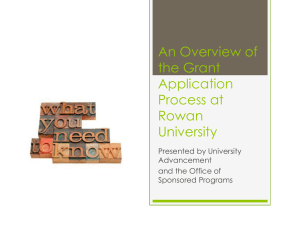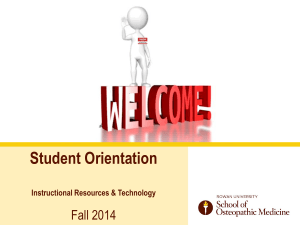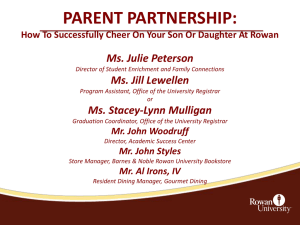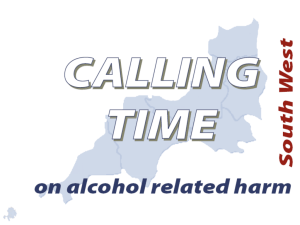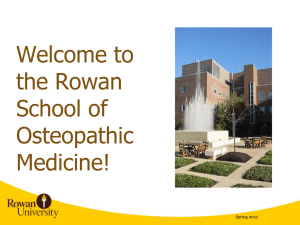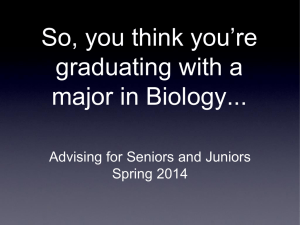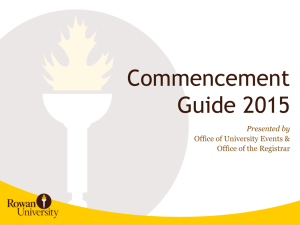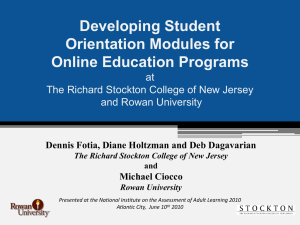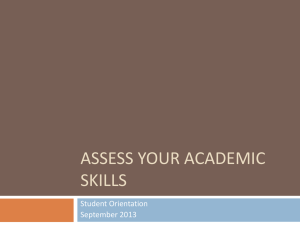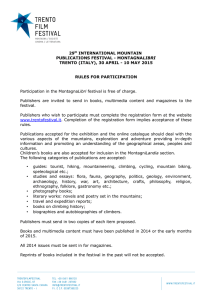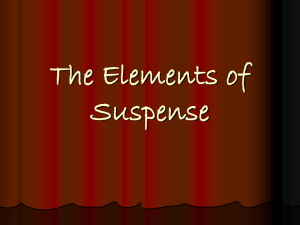here - Rowan University
advertisement
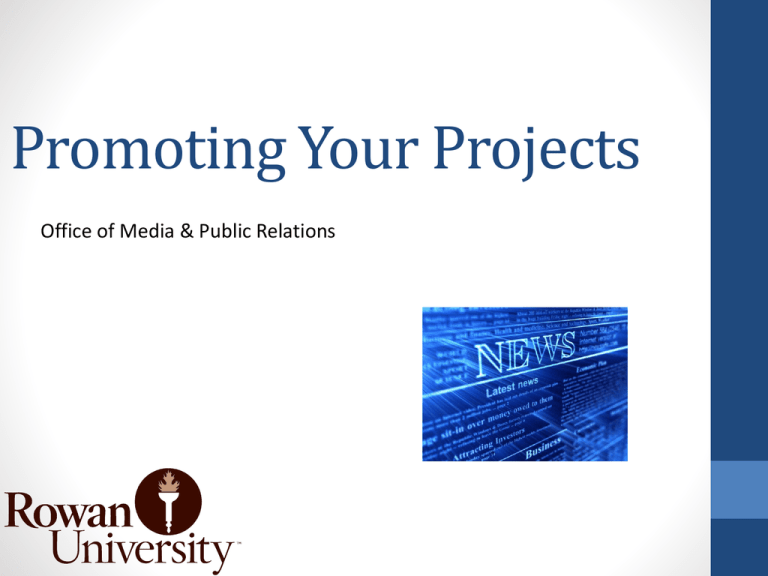
Promoting Your Projects Office of Media & Public Relations news ͞ /n(y)ooz/ Newly received or noteworthy information, esp. about recent or important events. A broadcast or published report of news. Synonyms tidings - information - report - message - word Who? Various offices and departments on the Rowan University campus serve communication functions, most of them under the umbrella of University Relations. • • • • Media & Public Relations University Publications Web Services University Events With several colleges, communications officers work closely with administrators as part of a team that together establishes communication plans and develops annual reports, newsletters and collateral materials as well helps determine (and address) key messages. The Office of Media & Public Relations WHAT DOES THIS OFFICE DO? Media relations, news conferences, Family & Neighbors newsletters, Campus News section of Rowan Today, the RUndown, production of several colleges’ newsletters and annual reports in conjunction with freelancers . . . Contacts: Dr. Joe Cardona Interim Vice President for University Relations (856) 256-4236 cardona@rowan.edu University spokesman, handles crisis management and strategic planning, among other responsibilities Patricia Quigley Assistant Director of Media & Public Relations (856) 256-4241 quigley@rowan.edu Colleges of Engineering and Sciences & Mathematics, Rohrer College of Business, South Jersey Technology Park, Research Barbara Baals Assistant Director of Media & Public Relations (856) 256-4583 baals@rowan.edu Colleges of Education and Humanities & Social Sciences and the Camden campus The Office of Media & Public Relations • Dennis Dougherty Coordinator of Public Relations (856) 256-4537 doughertyde@rowan.edu Colleges of Communication & Creative Arts and Performing Arts • Rosie Braude Communication Specialist (856) 256-5439 braude@rowan.edu The RUndown, Neighbors and Family newsletters; video campaigns; events, including Commencement • Steve Levine Writer/Editorial Specialist (856) 256-5443 levines@rowan.edu Writing, editing, email marketing, online writing and copywriting University Publications • Ever read Rowan Today or a postcard from an RU college or a brochure? Odds are University Publications had something to do with it. • WHAT DOES THIS OFFICE DO? This department is responsible for Rowan Today (our alumni magazine), the president's annual report with Media & PR, brochures, publication templates, postcards, advertisements, donor tributes, maintaining graphics standards, support for social events and videos, among many more items. University Publications and the Office of Media & Public Relations work together virtually daily. Representatives from both departments often participate in overall planning strategies. • Contact: Lori Marshall Director (856) 256-4197 marshall@rowan.edu University Web Services • WHAT DOES THIS OFFICE DO? Web Services oversees the Rowan University website and those websites that are elements of it as well as social media for the University at large (Facebook and Twitter). • Contact: Jen Bell Director (856) 256-4410 bellj@rowan.edu University Events • WHAT DOES THIS OFFICE DO? University Events coordinates major University-wide and presidential events, including Commencement, the Presidential Lecture Series and Convocation. • Contact: Christine Deehan Director of University Events (856) 256-4107 deehan@rowan.edu What? • So what’s news? What gets you in a newsletter? What might interest a TV reporter? What lands you in a trade publication? How do you get on the Rowan home page? • First you need to know this: there is no guarantee. The most exciting story, the best science, the warmest human interest piece – none of them comes with an ironclad guarantee of coverage. • The state of media today is in flux. That said, here are some things that have worked in the past: Be first Think: inventions, patents, cutting-edge research. Do you have a one-of-a-kind piece of lab equipment? Did you just get a discovery published? Are you flying to Mars? Or biggest You get it. Superlatives may be news. Or best Awards are good! Awards from prestigious organizations are even better. Show me the money Money does indeed talk. If you receive a major grant, you have story potential. Play well with others Collaborations with well-known institutions are a plus. So is outreach — local, international, it’s all good. More . . . What? • Feature stories / news stories • http://www.rowan.edu/today/news/index/PR/3267 (press release) • http://www.rowan.edu/today/news/index/FS/343 (RU web story) • Profiles (example, major new hires) • http://www.rowan.edu/today/news/index/FS/206 (Paul Katz, website) • https://alumni.rowan.edu/default.aspx?page=RowanMagazine/ (Ali Houshmand, Rowan Today, the alumni magazine) • Expert pitches • http://www.rowan.edu/today/news/index/PR/3236 • http://www.rowan.edu/today/news/index/PR/2926 • Briefs (awards/publications/appointments) • http://www.rowan.edu/today/news/index/PR/3308 • Media advisories (events) What Again . . . RU Communication a few examples • Rowan Website • www.Rowan.edu • Rowan Today • https://alumni.rowan.edu/default.aspx?page=RowanMagazine • College of Engineering Publications • http://www.rowan.edu/colleges/engineering/newsletter/ • Rowan News Site • http://www.rowan.edu/today/news What is News? From Fair Test • Experts agree that defining news can be a difficult task. Most journalists agree that the following eight elements make up what is considered "news." • Immediacy: Reporting something that has just happened or is about to happen. Time is a strong ingredient, "today, yesterday, early this morning, tomorrow." The newness of the occurrence makes up "immediacy" in the news. • Proximity: Facts and occurrences that are important to you personally; inflation, the Iran situation particularly if one of the hostages is someone you know or a family member of a close friend, the closing of a fire station close to your home. Such a closure is less important when it occurs across town. The question most asked by journalists is: "If this happened outside my immediate area, my city, my state, would I be interested in reading about it?" Keeping this question in mind is particularly important to the organizational PR person. You must "take off the I love this organization hat" and examine your story to see if indeed it would interest other readers. • Prominence: Prominence as a news element is well-known to most of us. The public figure, holders of public office, people of renown or those who stimulate our curiosity, people in positions of influence all enjoy news prominence. For your visitor or speaker to qualify for news prominence, he or she must be well enough known to command the attention of readers either by reputation or by the nature of the topic to be discussed. What is News? From Fair Test • • • • • Oddity: Oddity is often news. The bizarre, the unusual, the unexpected often make news. Generally those people who perform striking feats in emergency situations are news, such as a woman lifting an automobile off her child, traveling around the world in a sailboat, unusual recycling methods, use of materials in a different way. In journalism, oddity is defined as the "man bites dog" formula. Consider the reported rabbit attack on President Carter. That certainly made the "news." Conflict: Conflict is one element most observed in today(‘s news) with the clash of ideologies making headlines worldwide. Although most businesses and organizations shy away from the reporting of conflict, it is understandable that this element is firmly based in the news formula. Suspense: Suspense creates and expands news appeal. The outcome of the Iranian hostages is suspenseful news. For the most part, organizations would rarely experience this type of circumstance. It is helpful to remember that news suspense is not the same as mystery suspense. However, mystery suspense in news does occur when a crime has been committed and the search is on for a suspect. Emotions Emotions are a news element commonly called "human interest" stories that stir our recognition of the basic needs both psychological and physical. Stories that prompt the reader toward sympathy, anger or other emotions in all their variety are commonly handled in feature-type stories. Organizations should be alert to the possibilities of "human interest" stories. Consequence The last element of news, consequence, is more difficult to explain, but generally for a story to have consequence it must be important to a great number of readers. It must have some impact for the reader. Such news will affect him or her in some personal way...the safety of the city's drinking water. The dumping of toxic wastes into the Snake River Aquifer is being examined from the standpoint of consequence now and in the future. Thus it becomes an important news story. When? • Many of our communication activities are ongoing, for instance media relations. Please don’t contact us on a Thursday about an event on Saturday. We need time to pull stories together (even media advisories), and media need notice. Give the PR folks at least (at least!) two weeks’ notice. • Rowan Today prints twice a year. • Family and Neighbors newsletters are issued twice a year. • The RUndown is published electronically once a month except during winter break and Commencement. • Collateral materials are produced throughout the year. Where? • We can use your help in building media lists. If you have a “dream” publication you would like to see Rowan people or programs appear in, please contact the PR person assigned to your College. • Rowan professors and students have appeared in everything from Reader’s Digest to the Jerusalem Post and on 20/20 to CNN. Why? And a bit of this and that • Tell us what you need. The University is going through many changes. If we cannot take on a project directly, we will try to connect you with someone who can. • When you contact us about a potential story, please send us or tell us the basics: who, what, when, where, why. Abstracts, if you have them, are great. • Keep in mind University priorities, which include research and how it impacts students, regional economic development and the community overall. Those priorities also include development of the College of Health Sciences and integration of the School of Osteopathic Medicine. • Think visually. • Some things to keep in mind: • • • • Communicators are people, too. Please be patient! Every person I know well in our departments really likes his/her job. That doesn’t mean we don’t appreciate people who make them easier! • Share stories. Share 10 stories. Even if only one has merit, that’s one story that may gain you or our students attention. Sharing 10 and having one viable one is better than not sharing at all!
